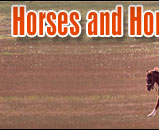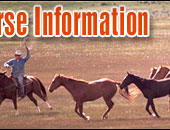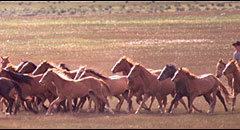 |
   |
|
|
|
You are here: Horses > Horse care > Field of schemes |
Proper Horse Handling Techniques
Every horse owner has experienced the feeling of walking into a pasture to
capture a horse and suddenly being surrounded by many curious equines. Suddenly
a single 120 pound you is surrounded by a dozen or more ďthemsĒ that weigh at
least 1,200 pounds. One reassuring fact is that they arenít carnivores, but
still what should you do?
|
|
|
The best thing to do is just to ignore them. As you walk
past them to get your horse they will realize that there are
no treats for them and then they will usually leave you
alone. Shove away any persistent horses since it will give
them the message that you are not interested in them and
then they will generally retreat. You can also let the
horses know you donít want to be fooled with by walking
through the pasture with an aggressive, confident posture
towards those you donít want to catch. |
Of course when catching a horse you should never walk in
with a bucket of grain since this is an invitation to being
mobbed. Keep any treats hidden in your pocket if you want to
give them to your horse. Then when you catch your horse you
can give them the treat or you can wait to give the reward
once you are outside the gate. It is best to teach your
horse to understand that they are rewarded only once they
are caught and taken through the gate.
If a horse is causing problems in the pasture such as
kicking and biting while you are trying to lead away your
horse then it will need to be removed. If an aggressive
horse threatens people then it needs to be kept out of a
pasture situation where there are people. The owner can be
liable if there is a horse that is known to be aggressive
and it attacks someone that is leading a horse. Legal
problems can occur if a horse has a history of being
aggressive and then hurts someone in the pasture.
Prevention is the key with most problems. Knowing each of
the horses that are in the pasture is the best thing. You
likely wonít have to worry about going to get your horse if
the situation is usual and safe for you. Allow your horse to
be happy when they are caught and then this way you wonít
have to chase them around the pasture. After catching a
horse donít always ride them hard, rather on occasion catch
them and take them inside where you give them a treat and
groom them before putting them back out.
When releasing the horse back into the pasture it is
important to do so calmly. Shut the gate after walking the
horse in and then give them a pat after slowly taking off
the halter. Without the halter on make the horse stand
beside you until you walk away from them. When turning out a
horse you should never chase them since this can lead to
problems where they will want to race away the moment you
loosen the halter.
Grab some mane and start scratching a horseís ears if they
want to run off as soon as you loosen the halter. This can
help slow them down before they decide to run. A real hazard
is a horse that wants to turn around and kick whoever just
released them and this should be treated as a major
behavioral problem. A harmonious pasture comes from having
compatible mates.
Your pasture should have enough room to allow you to place
you hay in several piles so that horses who are lower in the
pecking order wonít be driven away from the food by others.
For example there should be seven piles of hay for six
horses. You should give enough food so that your horses
wonít fight over the food.
The pecking order is always going to have a horse on the
bottom and this is fine as long as that horse isnít getting
injured. You may have to rearrange your horses if the lowest
horse is getting injured.
A gelding that thinks they are a stud is one pasture
problem. You shouldnít place this type of a horse in with
any mares. This doesnít mean that all mares and geldings
should be separate; rather the geldings that exhibit sexual
behavior towards the mares should be kept separate.
A gelding should be kept separate from the mares if they put
their head down and try to hear the mares or you. The
sexually aggressive behavior can be reduced with medications
if you have no other place to put these horses.
You should slowly introduce any new horses to the pasture.
It is a good idea to hand introduce a horse over the fence
provided you have the facilities and safe fencing. Placing
the new arrival in with a soon-to-be-pasture mate in a
paddock is one idea to try. For example is you have horses
A, B and C out to pasture and you want to add D then you can
first place D and C together before adding B and A. This way
D wonít be treated so badly.
If you must place a new horse in pasture with others because
of your facilities then you should at least have a pasture
that is big enough to allow the horse to get away if needed.
You should also make sure you have safe fences; this is the
most important factor that canít be stressed enough.
In order for you to keep an eye on the pasture during the
day you should try introducing new horses early in the day
so that you can monitor them during the daylight hours in
case something goes wrong. Although most of the time horses
will get along when they are first introduced.

|
Read the next horse care article on Caring for Your Horse Basics. |
|
|
|
|
 |
|
|
|
|
|
Horse Education
|
|
|
|
|
Horse Information Topics
|
|
|
|
|
|
|
|
Horse Business Owners
|
| |
Advertise with Us
Have your horse products or services exposed to over 27,000 of our monthly visitors.
|
|
|
|
|
|